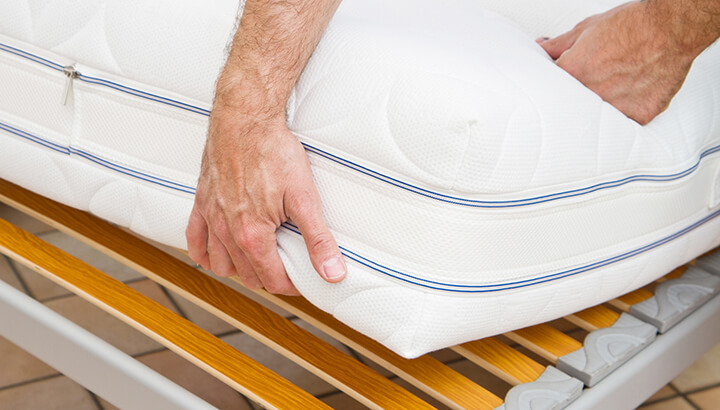
The average person will sleep for around 25 years in their lifetime. That makes sleep kind of a big deal. Sure, some of that time might be spent napping on the couch, at your work desk or in a sun-drenched hammock. But the lion’s share of that sleeping occurs in your bed, on a mattress. That makes getting the right mattress one of the most important things you’ll ever do.
Unfortunately, the importance of a quality mattress is lost on most people. And in most cases, those people that do take the initiative and seek out a “quality” mattress are often looking for the wrong attributes.
Certainly, comfort and posture support are important. But there’s a more sinister side to the mattress industry that those high-quality brands aren’t telling you about. Really, when you’re looking for a quality mattress, the safety of your health and the health of your family should be first and foremost.
So what constitutes a “safe” mattress? How do you even know how to find a safe mattress? To help you find that all-important perfect mattress, let’s first look at what to avoid in your sleeping substrate.
What harmful compounds are lurking in that mattress?

Most of the time, you’d be hard pressed to find out what’s in your mattress, or how safe it really is. Manufacturers aren’t legally required to report which chemicals are in their mattresses, regardless of how they might harm your health.
A classic example of this is flame retardant chemicals. Health and safety legislation dictates that all mattresses produced on or after July 1, 2007 must be resistant to a certain amount of fire damage. And while the intentions behind this legal requirement are good, the result is bad. In order to be flame retardant, manufacturers pump these mattresses full of toxic chemicals.
Flame retardant chemicals
Polybrominated diphenyl ethers (PBDEs) are a particularly popular group of chemicals that make mattresses more resistant to fire. The U.S. government banned these chemicals in 2004 due to serious health concerns. You know it must be bad if the authorities have classified it as a no-go!
A study completed in 2001 found that PBDE caused “behavioral effects” in mice during the “critical period after birth.” The study went on to conclude that there are many important gaps regarding our scientific knowledge of PBDEs, including carcinogenicity, reproductive and developmental toxicity.
Another 2003 study found that PBDEs were being found in alarming levels in U.S. mother’s breast milk. Yet another reported that PBDEs “are relatively mobile, and may readily migrate (leach) from products into the surrounding environment during normal product use, life cycle and disposal.”
Clearly, you don’t want these chemicals in your mattress. Research shows that children born to women who were exposed to PBDEs had an average decrease in IQ of 4.5 points. Several studies also indicate reduced fertility in women due to PBDE exposure, along with lower thyroid-stimulating hormone production during pregnancy.
Many people have mattresses which pre-date 2004, meaning there’s a good chance that these concerning chemicals are lurking within their lumpy depths. This is especially the case if your mattress contains polyurethane foam.
Boric acid
And while PBDEs may be a thing of the past, there’s a whole host of other noxious flame retardants which have dropped under the legal radar. One such chemical is boric acid, which people originally used in the eradication of cockroaches.
Researchers have shown high doses of boric acid to produce testicular lesions in rats, “characterized by inhibited spermiation followed by atrophy.” Not something you’d particularly want to happen to you or your male counterpart, but it’s altogether possible if your mattress has been treated with this potent flame retardant. While researchers haven’t shown this compound to be harmful at low doses, over time it can leach out of your mattress and into your skin and lungs. This study also indicates that boric acid has the potential to alter follicle stimulating hormone and testosterone, and also affect prenatal growth and development.
It doesn’t stop there. A 2009 study published in the Journal of Environmental Science and Technology noted that “it has been difficult to determine which chemical formulations are currently being used in high volumes to meet flammability standards since the use of flame retardant formulations in consumer products is not transparent.”
More toxic chemicals
Researchers analyzed foam samples from 26 pieces of American furniture, including mattress pads and futons, in order to get to the bottom of the matter. Researchers analyzed these items using chromatography and mass spectrometry. Their findings were as follows:
- Fifteen samples contained the flame retardant tris (1,3-dichloro-2-propyl) phosphate (TDCPP)
- Four samples contained tris (1-chloro-2-propyl) phosphate (TCPP)
- One sample contained brominated chemicals
- One sample contained PBDEs
All these compounds are similar in structure to organophosphate pesticides, which are classified as neurotoxins. A study published in the Journal of Environmental Chemicals and Neurotoxicity found that the flame retardants TDCPP and TCPP, which were found in most of the samples in the previous study, can cause multiple different kinds of toxicity in the human body. Researchers also concluded that these chemicals may significantly affect brain development and elevate free radical stress on human cells.
You get the point. Most mattresses are bad news, regardless of when manufacturers made them. What’s more, many of these mattresses are still susceptible to fire. Mattresses treated with flame retardants actually produce higher levels of carbon monoxide, soot and smoke than nonflame-retardants, making these fires more deadly.
This 2010 study notes that “reducing the use of toxic or untested flame retardant chemicals in consumer products can protect human and animal health and the global environment without compromising fire safety.” But until the authorities catch up with the rest of this on this matter, how do you find a safe mattress in the meantime?
Finding a mattress which won’t harm your health

Perhaps the easiest thing you can do to avoid harmful chemicals is to talk to your doctor. Many people are allergic to these chemicals. Simply tell your doctor that you have an allergic reaction, and they’ll write you a prescription for a chemical-free mattress. You can then order a flame retardant-free mattress from certain pre-approved manufacturers.
You can also track down your own chemical-free mattress. Manufacturers don’t add flame-retardant chemicals to wool mattresses. Experts already consider wool to be a natural flame retardant. What’s more, knowing what labels to look out for with regards to mattresses can make a big difference.
Committing to only buying Global Organic Textile Standard (GOTS) mattresses can be a good start. GOTS requirements stipulate that these mattresses must contain at least 95 percent certified organic materials. They also prohibit the use of flame retardants in their products.
Choosing a truly organic latex mattress can also be a good choice. These mattresses are super comfortable. Manufacturers often wrap them in natural wool to ensure breathability and flame retardancy without the chemicals. Choosing mattresses with the Global Organic Latex Standard (GOLS) label is one of the best ways to ensure it’s organic.
— Liivi Hess
While we’re on the subject of toxic household items, here are 10 other toxins found in your home that’ll have you running for the outdoors!

